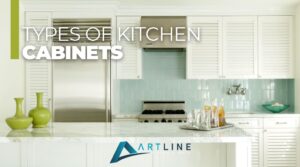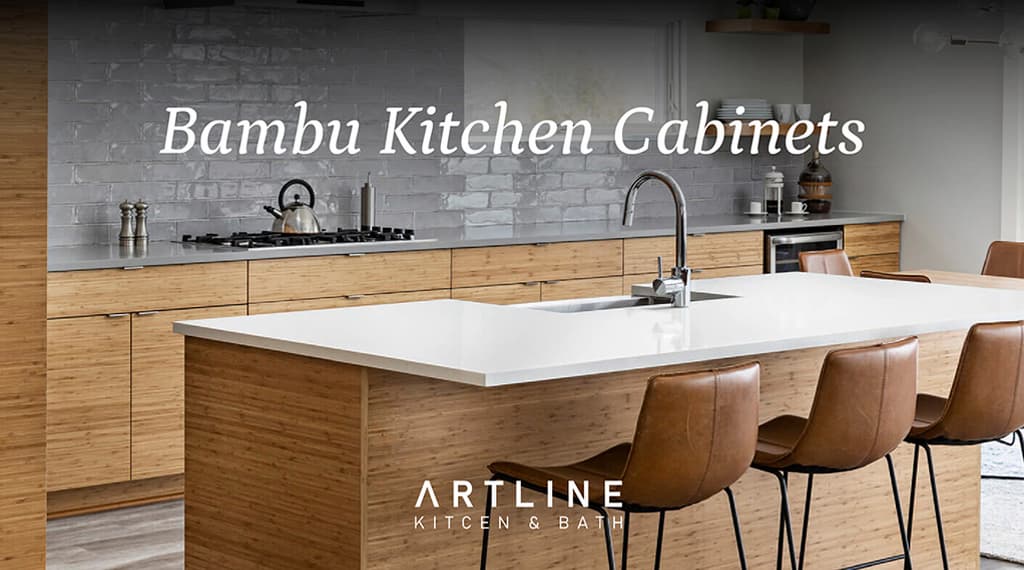Bamboo kitchen cabinets bring together smart design, eco-friendly values, and solid performance, making them a leading choice for 2025 kitchen renovations. According to recent studies, bamboo cabinetry appeals to homeowners seeking beauty, sustainability, and lasting value. Imagine the warmth of natural grains or bold espresso tones anchoring a modern kitchen; bamboo offers customizable style without environmental compromise.
Table of Contents
ToggleWhat Makes Bamboo Cabinets Stand Out?
The market for bamboo cabinets has grown sharply in the last five years, thanks to their renewable source and impressive durability. Although bamboo resembles wood, it’s technically a grass, reaching full maturity in three to five years versus up to 60 years for hardwoods. This speedy regeneration places minimal strain on forests, and statistics show over 35 million acres of bamboo are cultivated each year for eco-friendly products. Additionally, bamboo absorbs up to 35% more carbon dioxide and releases 30% more oxygen compared to an equivalent patch of trees, directly benefiting air quality during cultivation.
Key Benefits of Bamboo Kitchen Cabinets
Eco-Friendly
With harvesting practices leaving bamboo’s root systems intact, local ecosystems remain stable even as demand grows rapidly. Fewer chemicals and pesticides are necessary. Recent data show that bamboo cultivation uses at least 80% fewer agrochemicals than most hardwood production. Environmental impact studies confirm that eco-upgraded kitchen projects, such as bamboo cabinet installations, lead to a 17% reduction in home renovation carbon footprints. Choosing bamboo cabinets helps homeowners align with green-building standards while maintaining stylish appeal, regardless of kitchen size.
Tough and Durable
Bamboo’s dense fiber structure results in cabinets that are up to 25% harder than red oak and maple, according to industry durability ratings. They withstand daily use, resisting dents, scratches, and moisture better than many traditional woods. With proper sealing and finishing, bamboo cabinets last decades; market reports suggest a typical lifespan of 20 to 25 years, rivaling or exceeding most solid hardwood alternatives. Experts at Dura Supreme Cabinetry recommend bamboo for busy family kitchens thanks to its exceptional wear resistance.
Looks Great, Fits Any Style
Bamboo brings a unique, elegant grain, sometimes highlighted by occasional knuckles that add charm and texture to any kitchen. Its versatility lends itself to a spectrum of finishes: natural blonde for Nordic cool, espresso for drama, or rich honey and caramel for warmth. Interior designers increasingly use bamboo in transitional spaces, mixing minimalist and classic motifs; pairing with stone counters or glass tiles enhances depth and personalizes the space. Recent design surveys show that modern homeowners favor bamboo for both small and expansive kitchens, citing its fresh look and sustainable credentials.
How to Install Bamboo Kitchen Cabinets
Proper installation maximizes bamboo’s performance and appearance, and a strategic approach ensures seamless integration into your kitchen.
What are The Tools You Need?
- Power drill and screws
- Stud finder, level, and measuring tape
- Cabinet jacks or makeshift supports
- Shims for accurate leveling
- Safety glasses and gloves
Begin by thoroughly mapping your kitchen and identifying wall studs; this step averts costly errors. Studies from remodeling professionals highlight that pre-install planning reduces cabinetry installation times by up to 25% and minimizes finish damage.
Step-By-Step DIY Bambu Cabinet Installation
- Base Cabinets First:
Secure the first base cabinet to a corner wall. Level carefully with shims; achieving precise alignment prevents visible seams and operational issues. - Wall Cabinets Next:
While floors are clear, lift wall cabinets into position using a helper or a cabinet jack, aligning with marked levels. - Fasten Securely:
Attach cabinets by driving heavy-duty screws through the solid bamboo backs into wall studs. Bamboo’s hardness may require pre-drilling. - Install Hardware:
Select robust, bamboo-compatible hardware, as quality hinges extend cabinet lifespan. - Finishing Touches:
Check edges, fill gaps, and wipe down surfaces to preserve the finish.
ArtLine’s Troubleshooting Tip: Old homes with uneven floors benefit from meticulous shimming. Industry pros advise frequent measuring; uneven cabinetry can misalign doors and disrupt bamboo’s clean lines.
Modern and Traditional Style Options
From sleek, handle-less fronts to Shaker frames, bamboo adapts to any visual language. In 2023, over 40% of high-end remodels featured a blend of wood and engineered bamboo, revealing its popularity for versatility.
ArtLine Kitchen & Bath Styling Ideas
- Combine bamboo with glass tile or quartz countertops for a contemporary contrast.
- Use black metal pulls for industrial flair, or brushed brass for warmth.
- Vertical bamboo grain helps amplify small kitchen height and openness.
- Add painted accents in deep blue or sage for a cool, modern touch.
Explore more design inspiration at the ArtLine’s inspirational gallery.
Color and Finish Choices
Your finish selection shifts the atmosphere entirely. The National Kitchen & Bath Association (NKBA) 2024 Kitchen Trends Report explicitly notes that “texture is in, “with 35 percent of surveyed respondents expecting to see continued use of “natural, high-texture wood grain on cabinetry.”
The NKBA 2024 report states that “wood usurps white” signifies a major shift away from the previously dominant, often sterile, all-white kitchen aesthetic.
| Finish Type | Popularity (2024) | Recommended Style |
|---|---|---|
| Natural | 35% | Nordic, Japandi, minimal |
| Honey/Caramel | 25% | Transitional, warm classic |
| Espresso | 19% | Dramatic modern, industrial |
| Custom Colors | 21% | Eclectic, bold, personalized |
- Pro Maintenance Tip: Clean regularly with mild soap and a damp cloth. Avoid harsh pads or chemicals. Dry quickly to prevent water spots.
- Use mineral oil on micro-scratches, and lightly sand them, then reseal for deeper marks, a tip endorsed by bamboo cabinet manufacturers.
Keeping Bamboo Cabinets Looking New
Routine care is simple and adds years to your investment:
- Wipe up spills immediately to avoid moisture stains
- Place felt pads under countertop appliances
- Periodically check cabinets near sinks and ovens for wear
- Apply a natural oil finish every year to refresh luster
Cost Considerations
Bamboo cabinets are a mid-range investment; the cost per linear foot typically runs from $150 to $500, according to 2024 market estimates. This compares favorably to hardwood cabinets, which can exceed $800 per linear foot. While bamboo is pricier than MDF or basic laminate, it significantly outlasts them, saving money in the long term. Green home upgrades are shown to recoup up to 72% of their costs at resale, as modern buyers value eco-certifications and sustainable materials.
Cabinet Material | Avg. Cost/Linear Foot (2024) | Expected Lifespan |
|---|---|---|
Bamboo | $150–$500 | 20–25 years |
Oak/Maple | $500–$800+ | 20–25 years |
MDF/Laminate | $80–$200 | 5–12 years |
ArtLine Kitchen & Bath’s Offer: We provide flexible financing, making sustainable remodeling more accessible.
How Bamboo Cabinets Fit Any Kitchen
No kitchen is too small or too large for bamboo.
- Small kitchens: Pale vertical grain doors boost perceived brightness and help walls recede, making rooms feel open. Designers often recommend floor-to-ceiling cabinetry to create storage and visual height in tight spaces.
- Large kitchens: Mix dark bamboo islands with custom organizers or luxury countertops to achieve a stunning contrast. Industry stats show that in 2023, 12% of luxury kitchen designers used engineered bamboo for dramatic islands and wall panels.
- Organization: Bamboo’s flexibility makes it easy to build custom drawer inserts and built-ins, maximizing every inch.
The Environmental Impact
Bamboo’s environmental advantage lies in its rapid renewability and high carbon‑storage capacity. As a fast‑growing grass, bamboo matures in three to five years and can be harvested without replanting. Its dense, strand‑woven fibers store roughly 902 kg of dry material per cubic metre, half of which is carbon; this means a cubic metre of bamboo products can hold about 1 ,662 kg of CO₂, significantly more than many hardwoods.
Substituting bamboo for carbon-intensive materials, such as PVC or aluminum, avoids additional emissions. Estimates suggest that replacing a tonne of conventional materials with bamboo can save around 1.5 t of CO₂. Life‑cycle assessments back this up: bamboo‑based building elements cut embodied carbon by 46–88 % compared with typical construction materials
In practice, a bamboo‑earthen guest house in Thailand produced 5,496 kg CO₂‑equivalent, whereas a similar house built from standard materials emitted 17,692 kg CO₂‑equivalent, less than one‑third of the emissions. Even household items add up; an analysis of Southeast Asian homes found that bamboo products sequester 196–517 kg of CO₂ per household.
Because bamboo requires little fertilizer or pesticide and regrows after cutting, it exerts less pressure on ecosystems than many timber species. With proper management, bamboo plantations provide a renewable feedstock that locks away carbon and reduces the embodied emissions of kitchen cabinets and other home interiors.
To maximize eco-benefits, select cabinets manufactured with low-VOC adhesives and consider recycling or donating older cabinetry during your remodel.
FAQs About Bamboo Kitchen Cabinets
How should I clean Bamboo Kitchens?
Use gentle soap and a damp cloth; avoid harsh chemicals and dry right away for best results.
Which finishes and sealants are used in bamboo cabinets?
Choose natural, stained, or custom colors, most are finished with low-VOC sealers, helping your kitchen stay green.
Is bamboo tough enough for the kitchen?
Use gentle soap and a damp cloth; avoid harsh chemicals and dry right away for best results.
Can bamboo handle humidity and spills?
Properly sealed bamboo is moisture-resistant, suitable for kitchens even in humid climates.
Will bamboo cabinets add value to my home?
Yes. With growing interest in sustainability, bamboo cabinetry can boost resale value and appeal to eco-conscious buyers.
Are bamboo cabinets expensive?
They’re affordable compared to high-end hardwoods and offer a much longer lifespan than entry-level options.
Conclusion
Bamboo kitchen cabinets unite style, strength, and sustainability. Whether you’re embarking on a complete kitchen overhaul or a targeted refresh, bamboo is a sound investment for modern living.
To explore more ideas, request a quote, book your free design consultation, or visit the ArtLine Kitchen & Bath store. Your eco-friendly dream kitchen awaits!

Types of Kitchen Cabinets
Kitchen cabinets fall into three categories: customization level, layout, and style. Custom, semi-stock, and stock cabinets vary in flexibility and


Kitchen Cabinet Guide for Homeowners (2025)
Kitchen cabinets shape a kitchen’s look, feel, and function. From stock options starting around $100 per linear foot to fully

